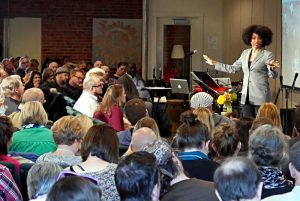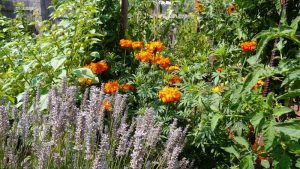By Andy Wade –
 I just returned from another amazing Inhabit Conference in Seattle. What I appreciate most about this conference is not the powerful keynote speakers, but the gathering together of everyday practitioners who are transforming their neighborhoods through simple acts of love and hospitality. The Parish Collective, which sponsors this annual gathering, is a central organization to link neighborhoods around the world through mutual support and the sharing of creative new expressions of living faithfully into place.
I just returned from another amazing Inhabit Conference in Seattle. What I appreciate most about this conference is not the powerful keynote speakers, but the gathering together of everyday practitioners who are transforming their neighborhoods through simple acts of love and hospitality. The Parish Collective, which sponsors this annual gathering, is a central organization to link neighborhoods around the world through mutual support and the sharing of creative new expressions of living faithfully into place.
Many of you know that I’m an avid gardener. You probably also know by now that the garden is one of my favorite places to talk with God and, more and more, a place to meet my neighbors. So I began wondering, what can the garden teach me about faithful presence? Companion planting immediately came to mind.
 A brief introduction to companion planting for those who are unfamiliar with it: Companion planting is the art of designing your garden with plants co-mingled in such a way that they protect and encourage the overall healthy growth of the garden. First Nations brothers and sisters were way ahead of us on this one (and many other things). What has come to be known as “the three sisters” – corn, beans, and squash – and the often overlooked fourth sister, sunflowers and Sunchokes, is a perfect example of companion planting. How does it work?
A brief introduction to companion planting for those who are unfamiliar with it: Companion planting is the art of designing your garden with plants co-mingled in such a way that they protect and encourage the overall healthy growth of the garden. First Nations brothers and sisters were way ahead of us on this one (and many other things). What has come to be known as “the three sisters” – corn, beans, and squash – and the often overlooked fourth sister, sunflowers and Sunchokes, is a perfect example of companion planting. How does it work?
Corn provides sturdy “poles” for the beans to grow on. The beans make the corn stalks more stable and able to withstand the wind. Additionally, beans “fix” nitrogen into the soil, giving essential growth nutrients to the corn and squash. Finally, the squash provides a “living mulch”, covering the ground with its leaves, keeping weeds down and helping the soil to retain moisture. When spiny squash was used, it also provided a level of protection from pests. This is a bit of an over-simplification, but it still works to illustrate the point.
Like gardens, neighborhoods are designed. Sure, some seem just to be tossed together and ignored, while others are carefully planned out, with neighborhood restrictions meticulously outlined in the CC&Rs (Covenants, Conditions, & Restrictions). Regardless of the neighborhood, we have a choice whether or not we’re going to live as beneficial neighborhood companions or isolated plantings cut off from one another. And this choice, though it will look different depending on the environment, transcends the urban, suburban, and rural divides.
When we choose to live isolated from our neighbors and neighborhood, we are much like industrial farms. This lifestyle requires compartmentalizing life into bite-size, controllable chunks, seemingly independent of one another. Industrial farming focuses on growing one crop (sometimes two) on large plots of land. These mono-crops produce massive amounts of cheap food by paying low wages to farm workers, pouring excessive amounts of dangerous chemicals and artificial nutrients on the soil – depleting topsoil and destroying the community of micro-organisms in the soil which make it rich – then sending this tainted food to big corporate grocery chains that in turn sell it in communities but take the majority of the profits out of the local neighborhood. In both gardening and the marketplace, this is unsustainable and destructive.
Many of our neighborhoods are similarly designed. Single family dwellings of self-sufficiency. Homes bordered by fences and shrubbery. Single-stop “super stores” for quick, one-stop shopping – stores run by big corporations who siphon money out of the community. Our lives have been crafted to fit into neat little boxes with slick marketing to target each separate area of our lives. And it’s easy to slip right into each box as our 24/7 connections to even more boxes leave us exhausted and almost craving more isolation just to feel a sense of peace. But there’s another way, a healthier, more organic option.
What would it mean to live in neighborhoods more like “the three sisters”? On a very basic level, what are the key aspects of this garden relationship that are also central to wholeness and flourishing in the neighborhood?
- Who/what “feeds” your neighborhood with rich nutrients so it can thrive?
- Can you identify people and places that are already present giving life to our community?
- In what ways do you “feed” my neighborhood?
- How might your choices actually drain life and vitality from my neighbors?
- Who/what gives support/strength/stability to your neighborhood?
- Again, can you identify people and places already providing economic, social, and emotional stability?
- How can you partner with what’s already going on here?
- Who/what provides that “living mulch” that keeps your neighborhood weed-free and well watered
- This could be a tough one, but what things are draining life and vitality from your neighborhood? Now the even tougher question: which of these things are “weeds” that need to be extracted, and which are perhaps seen as weeds but are actually good things poorly integrated into the neighborhood? In the garden there are a variety of plants you might want, but they might have a negative impact on each other when planted next to each other.)
- And finally, how do all of these parts of your neighborhood work together to provide a sustainable, healthy, living environment for all its residents? How are they connected?
This last point could (and might be) a whole new post. Beyond the three (or four) sisters, there is the whole soil environment. Within that soil environment is an entire network (literally) of mycelium, the roots of mushrooms that move nutrients throughout the garden and are essential for the garden to thrive and be sustainable. If you’ve ever dug around in the ground and discovered delicate white threads in bunches and branching out all over the place, that’s mycelium!
Why I bring this up is that our neighborhoods, no matter how broken, also have this delicate underlying mass of threads. One of the many issues about gentrification is that it ignores this essential tangle of connections that keep an area alive. As we ask the questions outlined above, it’s imperative that we identify, as best we can. what the “mycelium” in our neighborhood is. How does it work to hold life together? How can we move forward without so disturbing the “soil of our neighborhood” that we fatally damage the “mycelium” that has kept it alive over the years?
- What does your neighborhood look like?
- Does it look differently if you see it as a garden?
- As you look at your neighborhood, what companions are already planted there?
- Can you think of new things that could come alongside what is already present to make them stronger?
I’d love to hear your questions, ideas, and stories!
